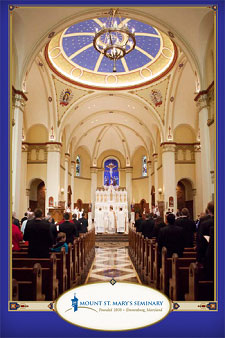Liturgy, Properly Done
 At the invitation of Ms. Julia Parker, Director of Liturgical Music, I spent a wonderfully pleasant afternoon with the Fourth Year Diaconate Class of Mount Saint Mary's Seminary in Emmitsburg, Maryland.
The purpose of the visit, my first to this seminary, was a presentation to the deacons on the intersection of liturgy and music, particularly on the parish level.
They were keenly interested in not only how a parish music program could be structured, but also in how a program specifically contributes to good liturgy.
At the invitation of Ms. Julia Parker, Director of Liturgical Music, I spent a wonderfully pleasant afternoon with the Fourth Year Diaconate Class of Mount Saint Mary's Seminary in Emmitsburg, Maryland.
The purpose of the visit, my first to this seminary, was a presentation to the deacons on the intersection of liturgy and music, particularly on the parish level.
They were keenly interested in not only how a parish music program could be structured, but also in how a program specifically contributes to good liturgy.
Seminarians at Mount Saint Mary's, about 165 strong, come from dioceses all across the country.
There is indeed a wide variety of backgrounds — these future priests come with a broad spectrum of musical training.
Some have none; some are Gregorian chant scholars.
The discussion with the deacons that afternoon took all that into account.
I. Polyester Liturgy
We first looked at where vernacular musical liturgy had been in the United States.
From its infancy, rooted in the new pop-culture styles of the 1970s, we noted with a degree of remorse that many parishes have yet to move beyond that milieu.
Examples of "polyester" liturgy can be found in every diocese, I'm sure.
II. The Mess We're In
 To embrace some of the frustration of where we are now, we looked at a graphic of a Jeep hopelessly stuck in a muddy field, with the driver trying to dig it out.
Who's to blame for this situation?
To embrace some of the frustration of where we are now, we looked at a graphic of a Jeep hopelessly stuck in a muddy field, with the driver trying to dig it out.
Who's to blame for this situation?
- The U.S. bishops (especially in the 70s and 80s), who gave scant orthodox direction for music in liturgy — they created the mud.
- Music publishers, who produced abundant tawdry music and broke cleanly from any tradition — they sold us that invincible 4-wheel drive Jeep.
- Parish music directors, who bought up that poor quality music and taught it to hungry congregations — they drove right into the mud and got stuck.
The inglorious cycle had begun, wherein publishers put out a lot of junk, parish music directors bought it and taught it, people learned it and grew attached to it (because it was all they knew) and then demanded that their music directors buy more stuff like it.
Can you see the spinning tire?
III. The Results
That "mess" led to:
- The four-hymn sandwich
- Gathering Song
- Preparation of Gifts Song
- Communion Song(s)
- Sending Forth Song
By the way, can't we all agree to call these moments by the names they're given in The Roman Missal, the authority on the subject?
- A warped sense of "active participation"
- the false idea that "participation" only means "doing something physically" (particularly singing)
- an "entitled" congregation that absorbs every musical moment at Mass to itself
- the "liturgiometer" that measures the holiness of the people by the volume of their singing
- Straying far from the rubrical norm
- Ignoring the Propers [with, however, appropriate reverence for the assigned Scripture readings]
- Abandoning chant as the musical prototype
- Music Director "self-aggrandizement," wherein we lowly parish musicians have usurped from Holy Mother Church the power of creating liturgical text every time we program our favorite "song" to replace the official Proper text
IV. How Do We Fix This?
Fortunately, that Jeep above is no longer mired in the field; it was eventually extricated.
So how do we get out of the mud?
- Stay close ("white on rice") to the books:
- GIRM
- Roman Missal
- Liturgical documents
- Conciliar
- Vatican congregations
- Bishops' conference
- Diocesan
- Parish norms
- Work slowly and relentlessly
- Start where the parish is now
- Keep what's good
- Modify or eliminate what's bad … gradually
- Introduce the concept of Propers
- Use a responsorial Entrance Chant of some kind
- Find a seasonal, responsorial Communion Psalm
- Wean the congregation from hymn over-kill
- Replace one hymn, bit by bit, over several years
- Repeat
- Be extremely patient
- Keep your eye on the Roman Rite NORM:
- The congregation sings the Ordinary [consistent parts]
- Kyrie
- Gloria
- Credo
- Sanctus
- Agnus Dei
and all the dialogues, Amen, etc.
- The schola sings the Propers [variable parts]
- Introit
- Gradual -or- Psalm
- Alleluia -or- Tract
- Offertory
- Communion
Realize how absolutely radical is the above plan.
It's definitely the norm of the Roman Rite, but not likely to happen in the U.S. for many decades.
V. Resources
- The Propers in English
- The Propers of the Mass [Fr. Samuel Weber, Ignatius Press 2014]
- Saint Meinrad Entrance & Communion Antiphons [Fr. Columba Kelly, OCP 2014]
- English Propers Chants [John Ainslie, Liturgical Press 2014]
- Lumn Christi Simple Gradual [Adam Bartlett, Illuminare Publications 2014]
- Mass Propers for the Liturgical Year [Gary Penkala, CanticaNOVA Publications 2015]
- By Flowing Waters [Paul Ford, Liturgical Press 1999] This is an English version of the entire Graduale simplex
- Simple English Propers [Adam Bartlett, CMAA 2011]
- Simple Choral Gradual [Richard Rice, CMAA 2011]
- Choral Communio [Richarrd Rice, Hostis Laudis Company 2012]
- Introit Hymns [Christoph Tietze, WLP 2005]
- Lalement Propers [Jeff Ostrowski, Corpus Christi Watershed] These are Graduale Romanum texts set in English
- Laudate Communion Antiphons [Andrew Motyka]
- American Gradual [Bruce Ford]
- Plainchant Gradual [Palmer and Burgess]
VI. Is This Really Possible?
VII. What Can the Priest Do — All By Himself?
- Learn the dialogues, teach them to the congregation, and sing them frequently
- "The Lord be with you." "And with your spirit."
- Penitential Act
- Preface Dialogue
- Peace Rite
- Blessing & Dismissal
- Support good liturgy and good music
- Verbally
- Financially
- Spiritually [Do you pray for your musicians?]
- Preach on the Proper texts
- Look at the Introit for a homiletic kernel
- The Communion antiphon would make an excellent Eucharistic tie-in
- Preach on liturgy
- Why do we do, pray and sing what we do?
- "[The homily] should be an explanation of some aspect of the readings from Sacred Scripture or of another text from the Ordinary or the Proper of the Mass of the day …" [GIRM #65]
- Chant the Orations [Presidential Prayers]
- see The Roman Missal, Appendix I, for the simple and solemn tones — these latter are pointed for singing on CNP's Liturgical Planning Pages
- Chant the Gospel
- see CNP's Book of Sung Gospels
There is a wonderful future ahead for liturgical music in this country.
The fine men I met at Mount Saint Mary's Seminary are indicative, I'm sure, of the high level of liturgical awareness among newly-ordained priests these days.
Priests whose formation and liturgical training took place in the tumultuous, often heterodox, 1970s are now at or approaching retirement age.
May a new vision of musical liturgy the way the Church wants it be our goal for the next decades!
Article written 18 April 2016
|


 At the invitation of Ms. Julia Parker, Director of Liturgical Music, I spent a wonderfully pleasant afternoon with the Fourth Year Diaconate Class of
At the invitation of Ms. Julia Parker, Director of Liturgical Music, I spent a wonderfully pleasant afternoon with the Fourth Year Diaconate Class of  To embrace some of the frustration of where we are now, we looked at a graphic of a Jeep hopelessly stuck in a muddy field, with the driver trying to dig it out.
Who's to blame for this situation?
To embrace some of the frustration of where we are now, we looked at a graphic of a Jeep hopelessly stuck in a muddy field, with the driver trying to dig it out.
Who's to blame for this situation?